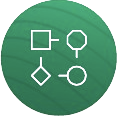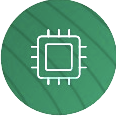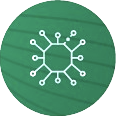The Future of Applied AI
Despite the difficulty predicting timelines, 1 recent signals are indicative of an imminent and transformative future:
| Recent Signals | |
|---|---|
 | Where traditional AI applications necessitated human oversight and intervention, new AIs are demonstrating the capacity to adapt to unfamiliar tasks—e.g., real-life autonomous vehicles 2:. Normally adaptation to novel environments would require human ingenuity, but machine learning innovations now enable AIs that mimic basic human intelligence. |
 | Thanks to modern advancements in semiconductors and their resulting computational capacities, today's AI models are increasingly capable of consuming vast quantities of data. Tokens—another name for the words and data used to train foundation models—are currently surpassing scales on the order of trillions. 3 |
 | A collection of dedicated forecasters believes that a single unified software system satisfying criteria involving benchmarks approximating human intelligence is likely to be publicly announced before 2030, more than 15 years earlier than the predictions made just 2 years ago. 4 |
 | The largest recent survey of AI researchers, published in January 2024, gives a 50% chance of AI systems achieving several large milestones by 2028, including autonomous construction of an e-commerce site, creating an indistinguishable original song, and independently fine-tuning an LLM. 5 |
An exciting future awaits us as these powerful changes take root in core functions of major global industries. We are likely to see discrete fields of machine learning—such as natural-language processing, computer vision, robotics, generative AI, and more—further and further intersect; their neat categorical boundaries will fade away as they collectively give rise to contextually-relevant, enterprise-grade AI applications. And as organisations discover novel combinations of both proven and emerging technological capacities we will increasingly see transformative AI applications at-scale. From healthcare and finance to manufacturing, logistics, energy, or retail, the application of AI technology will rapidly evolve from narrowly-applied analytics to more generally-intelligent, adaptive and autonomous systems.
Examples of Future AI Applications, by Industry:
| AI x Industry | Description | |
|---|---|---|
 | TRANSPORTATION | Self-driving vehicles for commuter mobility, intercity travel, and long haul delivery fleets6 7 |
 | HEALTHCARE | Machine learning for early diagnosis, individualized treatment plans, and predicting health outcomes 8 9 |
 | MANUFACTURING | Adaptive "CoBots" learning to work alongside human counterparts on complex or precise material handling, assembly, and packaging10 11 |
 | PROFESSIONAL SERVICES | High-fidelity, automated legal research, case review, and simulations for hyper-personalized advice |
 | FINANCE | AI to streamline the underwriting process and accelerate loan decision-making |
 | PHARMA | AI-enabled precision medicine to identify novel drugs fit for the genetic make-up of individuals |
 | TELECOM | AI-native 6G networks that self-learn to automate network optimizations and intelligent service provisioning for hyperconnectivity |
 | ENERGY | AI to accurately, adaptively and autonomously forecast power grid maintenance requirements |
 | RETAIL | AI-driven facial recognition to enable dynamic, personalized ads and discounts during in-store shopping |
Footnotes
-
Roser, Max. “AI timelines: What do experts in artificial intelligence expect for the future?”, 2023. https://ourworldindata.org/ai-timelines. ↩
-
Waymo. “Self-driving car technology for a reliable ride - Waymo Driver”, 2024. https://waymo.com/waymo-driver/. ↩
-
Hoffmann, Jordan, Sebastian Borgeaud, Arthur Mensch, Elena Buchatskaya, Trevor Cai, Eliza Rutherford, Diego de Las Casas, et al. “Training Compute-Optimal Large Language Models.” Computation and Language, March 29, 2022. https://export.arxiv.org/abs/2203.15556. ↩
-
Metaculus Forecasting, “When Will the First Weakly General AI System Be Devised, Tested, and Publicly Announced?” Date Weakly General AI is Publicly Known, January 18, 2020. https://www.metaculus.com/questions/3479/date-weakly-general-ai-is-publicly-known/. ↩
-
Grace, Katja, Harlan Stewart, Julia Fabienne Sandkühler, Stephen Thomas, Ben Weinstein-Raun, and Jan Brauner. “Thousands of AI Authors on the Future of Ai.” arXiv.org, January 5, 2024. https://arxiv.org/abs/2401.02843. ↩
-
Deichmann, Johannes, Eike Ebel, Kersten Heineke, Ruth Heuss, Martin Kellner, and Fabian Steiner. “Autonomous Driving’s Future: Convenient and Connected.” McKinsey & Company, January 6, 2023. https://www.mckinsey.com/industries/automotive-and-assembly/our-insights/autonomous-drivings-future-convenient-and-connected. ↩
-
Engholm, Albin, Anna Björkman, Yuri Joelsson, Ida Kristoffersson, and Anna Pernestål. “The Emerging Technological Innovation System of Driverless Trucks.” Transportation Research Procedia 49 (2020): 145–59. https://doi.org/10.1016/j.trpro.2020.09.013. ↩
-
Alowais, Shuroug A., Sahar S. Alghamdi, Nada Alsuhebany, Tariq Alqahtani, Abdulrahman I. Alshaya, Sumaya N. Almohareb, Atheer Aldairem, et al. “Revolutionising Healthcare: The Role of Artificial Intelligence in Clinical Practice - BMC Medical Education.” BioMed Central, September 22, 2023. https://bmcmededuc.biomedcentral.com/articles/10.1186/s12909-023-04698-z#Sec3. ↩
-
Myszczynska, Monika A., Poojitha N. Ojamies, Alix M. Lacoste, Daniel Neil, Amir Saffari, Richard Mead, Guillaume M. Hautbergue, Joanna D. Holbrook, and Laura Ferraiuolo. “Applications of Machine Learning to Diagnosis and Treatment of Neurodegenerative Diseases.” Nature Reviews Neurology 16, no. 8 (July 15, 2020): 440–56. https://doi.org/10.1038/s41582-020-0377-8. ↩
-
Faccio, Maurizio, and Yuval Cohen. “Intelligent Cobot Systems: Human-Cobot Collaboration in Manufacturing.” Journal of Intelligent Manufacturing, May 10, 2023. https://doi.org/10.1007/s10845-023-02142-z. ↩
-
Universal Robots. "UR5e Collaborative Robot Arm." Accessed April 17, 2024. https://www.universal-robots.com/se/produkter/ur5-robot/ ↩